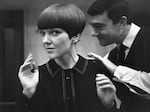
Designer Mary Quant, one of the leading lights of the British fashion scene in the 1960s, having her hair cut by Vidal Sassoon in 1964.
Ronald Dumont / Getty Images
Fashion designer Dame Mary Quant has died at her home in Surrey, UK, according to her family. She was 93.
Synonymous with the Swinging Sixties in London, she helped make hot pants, miniskirts and Vidal Sassoon bobs essential to the era's look. While still in her 20s, Quant opened an influential shop on Kings Road that evolved into a global fashion brand.
The daughter of Welsh schoolteachers in London, Quant was fascinated by fashion at an early age. Even as a child during World War II, she found the drab conventions around children's garments stifling.
"I didn't like clothes the way they were. I didn't like the clothes I inherited from a cousin. They weren't me," Quant explained in a 1985 interview on Thames TV. What she liked, she said, was the style of a young girl in her dancing class. "She was very complete. And her look! It's always been in my head. Black tights. White ankle socks... and black patent leather shoes with a button on top. The skirt was minutely short."
Quant's parents did not approve of fashion as a vocation, so she attended art school at Goldsmiths College, studied illustration and met and married an aristocratic fellow student, Alexander Plunket Greene. With partner Archie McNair, they opened a business in Chelsea in 1955, already stirring with what would become the "Youthquake" of the 1960s.
A self-taught designer, Quant wanted to make playful clothes for young modern women they could wear to work and "run to the bus in," as she put it. That meant flats, candy-colored tights, dresses with pockets, Peter Pan collars, knickerbockers, and above all, mini skirts.
"Because the Chelsea girl — she had the best legs in the world, " Quant declared in the Thames TV interview. "She wanted the short skirts, the elongated cardigan."
Quant helped elevate several of the era's top British models – Jean Shrimpton and Twiggy – and developed a line of makeup inspired partly by their unconventional application techniques, such as using blush on their lids. And she included an innovation of her own: waterproof mascara. Notably, she also hired Black models at a time when diversity was unusual in magazines and on runaways.
"She was one of the first female fashion designers to build an entire brand around her name," said John Campbell McMillian, a history professor who studies the 1960s. Quant, he notes, helped kick off the careers of photographer Brian Duffy, designer Caroline Charles and legendary Rolling Stones manager Andrew Loog Oldham, who had an early job as a shop assistant for Quant. "People who worked for her talked about how fun she was to be around, even as they worked at a blazing pace."
While Quant's brand never became as massive as Ralph Lauren or Gloria Vanderbilt, her partnership with JCPenney in the 1960s reflected her interest in affordable, accessible fashion. Her influence endures, with recent retrospectives dedicated to her work at the Victoria and Albert Museum and the Taipei Fine Arts Museum in Taiwan. And Mary Quant was the subject of an affectionate 2021 documentary directed by movie star Sadie Frost.
Copyright 2023 NPR. To see more, visit https://www.npr.org.